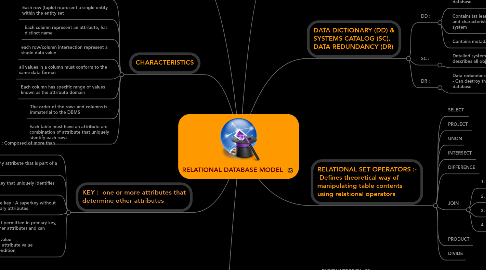RELATIONAL DATABASE MODEL
da nurul akmal


1. DEFINITION
1.1. Relational Model : View data logically rather than physically
1.2. Table : - Structural and data independence - Resembles a file conceptually
1.3. Relational database model is easier to understand than hierarchical and network models
2. CHARACTERISTICS
2.1. Table perceived of 2D structure compose of rows and columns
2.2. Each row (tuple) represent a single entity within the entity set
2.3. Each column represent an attribute, has distinct name
2.4. each row/column intersection represent a single data value
2.5. all values in a column must conform to the same data format
2.6. Each column has specific range of values known as the attribute domain
2.7. The order of the rows and columns is immaterial to the DBMS
2.8. Each table must have an attribute are combination of attribute that uniquely identify each rows
3. KEY : one or more attributes that determine other attributes
3.1. Composite key : Composed of more than one attribute
3.2. Key attribute : Any attribute that is part of a key
3.3. Superkey : Any key that uniquely identifies each row
3.4. Candidate key : A superkey without unnecessary attributes
3.5. Nulls : No data entry, not permitted in primary key, should be avoided in other attributes and can represent: i. An unknown attribute value ii. A known, but missing, attribute value iii. A “not applicable” condition
4. INTEGRITY RULES
4.1. ENTITY INTEGRITY : PK -Each table has column with unique values -No missing value for PK -Ensure traceable entities
4.2. REFERENCES INTEGRITY : FK -Values of a column in one table match values from a source table -Ensure valid references among tables
5. RELATIONAL SET OPERATORS :- -Defines theoretical way of manipulating table contents using relational operators
5.1. SELECT
5.2. PROJECT
5.3. UNON
5.4. INTERSECT
5.5. DIFFERENCE
5.6. JOIN
5.6.1. 1. Natural Join
5.6.2. 2. Equijoin
5.6.3. 3. Theta Join
5.6.4. 4. Outer Join
5.7. PRODUCT
5.8. DIVIDE
6. DATA DICTIONARY (DD) & SYSTEMS CATALOG (SC), DATA REDUNDANCY (DR)
6.1. DD :
6.1.1. Provides detailed accounting of all tables found within the user/designer-created database
6.1.2. Contains (at least) all the attribute names and characteristics for each table in the system
6.1.3. Contains metadata: data about data
6.2. SC :
6.2.1. Detailed system data dictionary that describes all objects within the database
6.3. DR :
6.3.1. Data redundancy leads to data anomalies - Can destroy the effectiveness of the database

